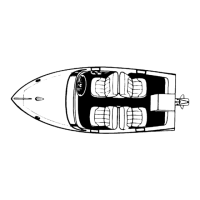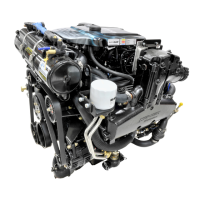1C-2 - TROUBLESHOOTING 90-823225--1 1096
Used Spark Plug Analysis
Use the following illustrations for determining ser-
viceability of spark plug. Spark plug condition also
can suggest a variety of possible engine malfunc-
tions and, therefore, can indicate needed engine re-
pairs. When old plugs are replaced, replace entire
set. Perform plug service only on those plugs suitable
for additional service, using the following proce-
dures:
1. Remove any oil deposits with solvent and dry
plugs thoroughly.
2. Open electrode gap wide enough to permit clean-
ing and filing.
3. Remove combustion deposits from firing end of
spark plug with a plug cleaner. Blow off with com-
pressed air to remove abrasives.
4. File electrode surfaces to restore clean, sharp
edges. Again remove filings with compressed air.
5. Reset gap to specifications by bending only side
electrode with proper tool.
Spark Plug Analysis
Normal Condition
Few deposits are present and probably will be light
tan or gray in color. This plug shows that plug heat
range is compatible with engine, and engine is elec-
trically and mechanically in good running condition.
With proper plug servicing (clean, file and regap), this
plug can be reinstalled with good results.
72420
Chipped Insulator
Chipped insulator usually results from careless plug
regapping. Under certain conditions, severe detona-
tion also can split insulator firing ends. Plug must be
replaced.
72420
Wet Fouling (Oil Deposits)
Plug becomes shorted by excessive oil entering
combustion chamber, usually in engine with many
hours of operation. Worn piston rings, cylinder walls,
valve guides or valve stem seals are causes of oil en-
tering combustion chamber. Only engine repairs will
permanently relieve oil wet fouling.
IMPORTANT: New engines or recently over-
hauled engines may wet foul plugs before normal
oil control is achieved with proper break-in pro-
cedures. Such fouled plugs may be serviced
(clean, file and regap) and reinstalled.
72420

